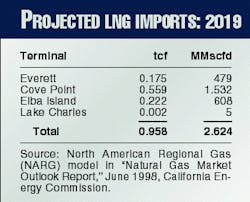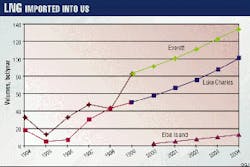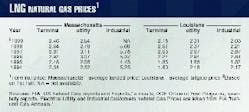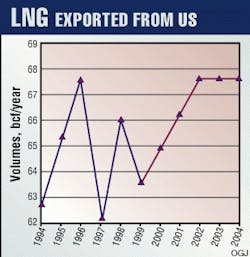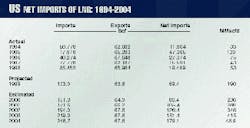After languishing for nearly 20 years, LNG imports to the US appear ready to play a moderate role in meeting short-term gas demands.
Long-term (after 2010), imported LNG will be a major source in meeting US East Coast natural gas demands, especially through the existing three East Coast receiving terminals.
Imports
Total 1998 LNG imports increased 9.9% to 85.45 billion cu ft (bcf) from 77.78 bcf in 1997. Algeria supplied 68.57 bcf, Australia 11.63 bcf, and Abu Dhabi 5.25 bcf.
About 49.8% of the imported LNG arrived at Distrigas Corp.'s terminal north of Boston; the remaining, at the CMS Trunkline LNG terminal in Lake Charles, La.
LNG imports during 1995 were at a very low level, not because of lack of US demand but because of limited supply.
Algeria's state-owned oil and gas company Sonatrach was the sole supplier of LNG to the US before 1996. In late 1994, Sonatrach started a major renovation project to restore its LNG plants to their original capacities. This project resulted in LNG export curtailments to all customers, including Distrigas and CMS Trunkline LNG. As the renovation of certain facilities was completed, Sonatrach increased its LNG exports in late 1996 and early 1997.
As several of Sonatrach's LNG plants were completed in 1996, LNG shipments to the Distrigas terminal increased. Also, Sonatrach's shipments to CMS Trunkline LNG's terminal increased during 1997.
Algeria's current LNG-export capacity has been restored to levels of before the start of its renovation project. In addition, the Maghreb-Europe natural-gas pipeline began operating in November 1996. This 1,162-mile pipeline transports Algerian gas to Spain and Portugal via Morocco and the Strait of Gibraltar. In doing so, the pipeline frees up more LNG export capacity; Spain currently is Algeria's second largest LNG customer.
The total value of LNG imported to the US in 1998 was $224.4 million at a yearly average price of $2.63/Mcf. The 1997 average price was $2.74/Mcf; therefore, the imported LNG price decreased 4%.
US receiving terminals
The four existing LNG-receiving terminals located along the US East Coast and Gulf Coast are shown in Table 1.
The Distrigas terminal was restarted in 1988 to receive LNG after being shut down in 1987. The quantities of LNG imported through the terminal during the 1994-1998 period and forecast quantities through 2004 are presented in Table 1; the data are shown in Fig. 1.
The terminal received 42.53 bcf (17 shipments) during 1998. Fifteen shipments (38.00 bcf) were received from Algeria and two (17.02 bcf) from Australia. There were 4 months (April, July, August, and September) during which no shipment of LNG was received at the terminal.
The terminal received 43.47 bcf (17 shipments) during the first half of 1999 and it is projected that the total yearly rate for 1999 will be 83.1 bcf.
The terminal primarily serves customers in New England. In the past, delivery of LNG from the terminal was mainly by trucks and some distribution by pipeline. However, new tie-ins to several local major natural gas pipelines and new industrial contracts have made major delivery changes in Distrigas' past operations.
In 1997, Distrigas received approval from the US Federal Energy Regulatory Commission (FERC) to expand vaporization capacity by 150 MMcfd, expand the marine terminal, and upgrade the terminal berthing facilities. The expansion and upgrading projects were completed in first quarter 1999.
A 10% annual growth rate is assumed, using the 1999 estimated LNG quantity of 83.1 bcf as a base point and extending the forecast period to 2004. Under this growth assumption, the Distrigas terminal will be utilized about 80% in 2004 at current capacity.
Trunkline's LNG terminal at Lake Charles reopened during 1989 and received one shipment of LNG from Algeria in December 1989. The quantities of LNG imported through the terminal 1994-1998 and forecast quantities through 2004 are presented in Table 1. The data are illustrated in Fig. 1.
The terminal received 42.92 bcf (17 shipments) during 1998. Twelve shipments (30.56 bcf) were received from Australia and two (5.25 bcf) from Abu Dhabi.
March and October were the only months during which no shipment of LNG was received at the terminal. It received 24.95 bcf (10 shipments) during first half 1999.
It is assumed that the total yearly rate for 1999 will be 49.9 bcf. The projected quantity of LNG for 1999 will be about 16% higher than that received during 1998.
The terminal is able to move vaporized LNG into many major natural gas trunk lines serving customers all along the middle and upper East Coast and in the central Great Lakes regions.
In recent years, the natural gas pipeline serving the expanding gas markets in Florida was expanded in deliverable capacity. Vaporized LNG from the Lake Charles terminal was to supply the additional natural gas demand in the Florida markets.
If any additional natural gas demand has occurred in Florida, gas supplies from offshore gas fields near Mobile, Ala., have met the demands. New production facilities at the offshore fields and additional distribution systems will supply up to 1.2 bcfd of treated natural gas to serve the Florida markets.
On Nov. 2, 1998, CMS Energy Corp. announced it would acquire all outstanding common stock of the Panhandle Eastern companies from Duke Energy Corp. for a cash payment of $1.9 billion and existing Panhandle debt of $300 million. This transaction was completed in March 1999.
The Trunkline LNG Co. at Lake Charles was part of the sale. The LNG terminal is under CMS Energy business segment: natural gas transmission, storage, and processing.
Although a 15% annual growth rate for importing LNG is assumed to take place in the lower Atlantic region, the Lake Charles LNG receiving terminal will be utilized at only about 41.4% by 2004.
Cove Point LNG LP is a joint venture between subsidiaries of Columbia Gas system and Potomac Electric Power Co. The limited partnership was formed on Oct. 23, 1993.
The Cove Point LNG facility continues to be used to liquefy indigenous natural gas and store the LNG for later regasification during the peak demand periods in the Central Atlantic and New England states.
Long-term, the facility is expected to be a receiving terminal for importing foreign LNG.
In July 1999, Sonat Inc. announced plans to reactivate Elba Island LNG receiving terminal beginning in 2002. It is assumed that one LNG shipment will be received in 2000 and two in 2001 to test the facility before fully reactivating it in 2002.
One shipment (2.5 bcf) is about 5% of the annual natural gas demand for industrial and electric utility consumers in Georgia.
Existing, new producers
LNG base load plants in Algeria provided the majority of LNG to the US marketplace through 1998. These Algerian facilities were assumed to supply LNG into mid-1999. This is the time frame covered by the current supply contracts.
Spot purchases of LNG began entering the US during 1996 from sources other than Algeria. About 4.95 bcf (two shipments) of LNG was imported from Abu Dhabi and received at the Distrigas terminal. Also, five spot purchases were made during 1997, one shipment (2.42 bcf) from Abu Dhabi and four (9.69 bcf) from Australia.
In 1998, seven spot purchases were made: two shipments (5.25 bcf) from Abu Dhabi and five shipments (11.63 bcf) from Australia. These increasing spot purchases indicate that LNG transactions are becoming more flexible and responsive to changes in the world marketplace.
The Atlantic LNG plant in Trinidad began LNG shipments to Distrigas' Everett receiving terminal in May 1999. Five shipments (10.65 bcf) were received at Everett during May and June from the Trinidad plant.
Another potential LNG supply source to the US market, the Venezuela Cristobal Colon LNG project, continues to be on hold.
LNG pricing
The projection of LNG entering the US market place does not consider product prices of low and high-cost LNG producers. We can get some guidance of LNG landing prices, however, from Sonatrach and other spot purchase sources of LNG into Distrigas and Trunkline terminals (Table 2).
One needs to compare these prices against the price history of natural gas being purchased by electric utilities and industrial customers in the states where the LNG terminals are located. These natural gas prices are presented in Table 2.
In reviewing the price history of the two customers, electric utilities and industrial, one can estimate in what markets imported LNG can be utilized as a base-load fuel.
When any new Atlantic Rim LNG producer comes on-line in the late 1990s or early 2000s, will US natural gas prices be high enough to attract new supplies of LNG? Or, will Western European customers be the home for the new supplies of LNG?
A major increase in US natural gas prices is needed to aid in attracting any new LNG producer. Higher natural gas prices, however, could bring more gas in from Canada.
Future imports
In June 1998, the California Energy Commission released its Natural Gas Market Outlook Report. The North American Regional Gas (NARG) model is the principal tool used by the commission to assess national gas market fundamentals.
Basic inputs to the NARG model include estimates of resource availability, production costs, pipeline capacity and transportation costs, regional demand projections, and other parameters defining the market fundamentals. The report covers a period out to 2019. LNG imports in 2019 are shown in the accompanying box.
The forecast LNG import values indicate that the existing capacity at the Cove Point and Elba Island terminals are exceeded and would require additional storage and vaporization facilities. The Everett terminal would be operating near the 90% level. The Lake Charles terminal would hardly be operating.
Based on the forecast values, imported LNG would be a major source of natural gas to meet the US East Coast natural gas demands in 2019.
Exports
The Phillips Petroleum Co.-Marathon Oil Co. joint venture exported 65.95 bcf from the Port Nikiski base-load LNG plant site on the Cook Inlet of southern Alaska for delivery to Tokyo Gas Ltd. and Tokyo Electric Power Co. Inc., Yokohama, during 1998.
The 1998 LNG shipments represented an increase of 6.1% over 1997 exports of 62.19 bcf. Bechtel performed the expansion of the LNG facilities during 1992-1993, making the increase in exports possible from the past annual average of 53 bcf.
The total LNG sales revenue to Phillips and Marathon was $191.6 million in 1998, a decrease of 19.6% over the $238.4 million received during 1997. The average selling price decreased 24% from $3.83/Mcf in 1997 to $2.91 in 1998.
The 5-year shipping price history (1993-97) of LNG leaving Port Nikiski is 1994, $3.18/Mcf; 1995, $3.41; 1996, $3.65; 1997, $3.83; and 1998, $2.91. The Japanese have been pressuring all their LNG suppliers to reduce the purchase price of LNG.
In 1998, seven countries supplied LNG to Japan: Australia, Brunei, Indonesia, Malaysia, Qatar, Abu Dhabi, and US. Indonesia was the major supplier at 36.6%, whereas the US supplied only 2.7% of the LNG imported into Japan.
As energy resources imported into Japan are price indexed to world crude oil prices and the world crude oil price decreased during 1998, the price of LNG imported into Japan decreased as well. In January, LNG leaving Port Nikiski, was priced at $3.67/Mcf. Therefore, the average price for the year was $2.91/Mcf.
The Phillips-Marathon joint venture signed an agreement with Tokyo Gas Ltd. and Tokyo Electric Power Co. Inc. in mid-1988 to continue LNG sales through 2004, then signed the initial 1967 contract that expired in 1989, with the two Tokyo utilities. Shipment from Cook Inlet to Tokyo began in 1969.
Under the new contract, two new LNG carriers (87,500 cu m each) deliver about 64 bcf/year of LNG in 17 trips at maximum demand rate. Delivery at this rate was started in 1993.
In reviewing the actual and forecast quantities of LNG being shipped from Port Nikiski (Table 3; Fig. 2), the contract quantity of 64 bcf/year was exceeded in 1995, 1996, and 1998. During 1997, however, the LNG quantity exported to Japan was 62.2 bcf.
Based on the first 6 months of deliveries of 1999, the projected shipping quantity of LNG for the full year of 1999 will be about 63.6 bcf. There is a mild slowdown in the Japanese economy requiring less power generation. As the economy picks up in the coming years, so will the power requirements, and in turn greater LNG needs.
Phillips operates the LNG plant and Marathon operates the LNG carriers. Sales and facilities' interests are split between Phillips (70%) and Marathon (30%). The feed gas to the LNG unit is provided by Phillips and Marathon from gas fields in the upper Cook Inlet area.
It is assumed that the Yukon Pacific LNG project will not affect the export of LNG from Alaska to Japan within the time period to 2003.
A small amount of LNG (33 MMcf) was exported to Mexico for the first time. The LNG originated at a new liquefaction, storage, and distribution facility near Topock, Ariz., on the Arizona-California border about 30 miles north-northwest of Lake Havasu City.
The LNG was sent to Sonoro, Mexico, by truck and sold to industrial consumers in the area. Truck shipments began in August and continued in October, November, and December. The trucks crossed the border at Nogales, Ariz.; the average border price was $5.69/Mcf.
Quantities, receiving-shipping states, pricing, and heating content of 1998 US imported and exported LNG are presented in Table 4. As the two receiving terminals are receiving LNG from three sources, they need to be aware of the quality of LNG being received to prevent possible "rollover" of LNG in their storage tanks.
The heating values of the imported LNG give an indication as to the quality and potential rollover problems.
The import-export LNG balance for the US as presented in Table 5 indicates that the US has become a net importer of LNG starting in 1997.
Although there is an estimated growth in importing LNG, it will play a moderate role in meeting short-term US gas demands.
The Author
Edward J. Swain is an independent consultant in Houston. He is retired from Becthel Corp., where he was a process planning engineer. Before joining Bechtel, he worked for UOP and Velsicol Chemical Corp. He has a BS in chemical engineering and an MS in business and engineering administration, both from the Illinois Institute of Technology, Chicago.

